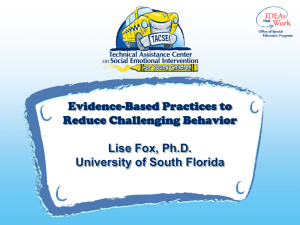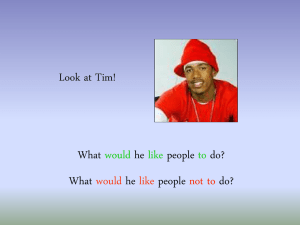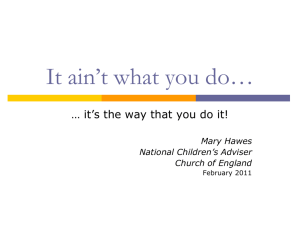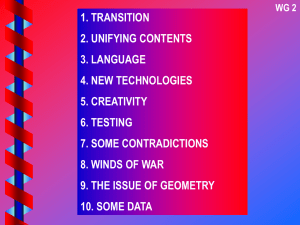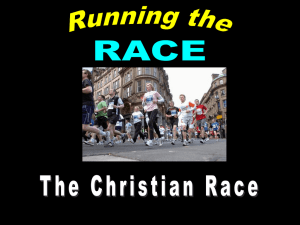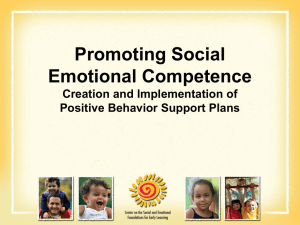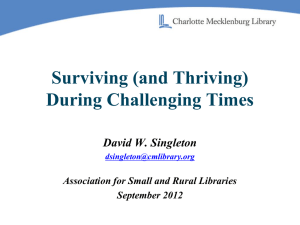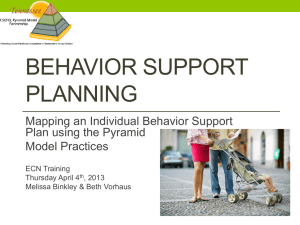Identifying Triggers and Teaching Replacement Behaviors
advertisement
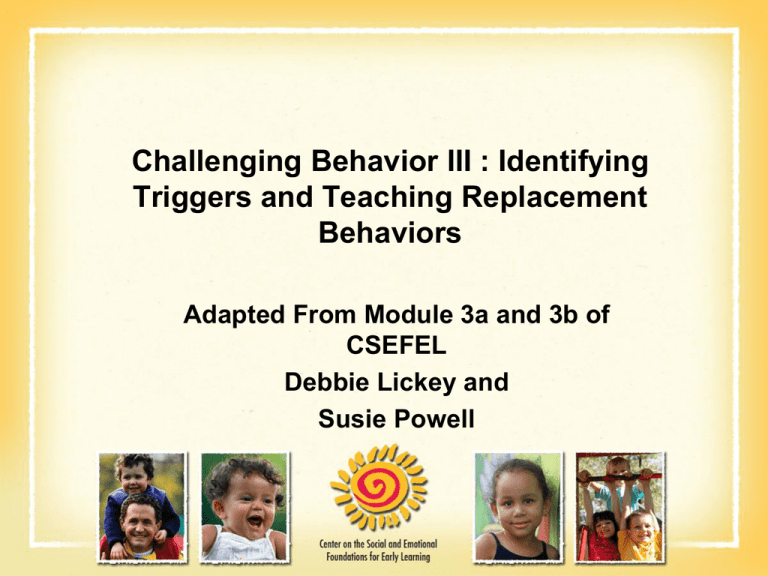
Challenging Behavior III : Identifying Triggers and Teaching Replacement Behaviors Adapted From Module 3a and 3b of CSEFEL Debbie Lickey and Susie Powell Opening: What do these acronyms stand for? • • • • • • • 7B47B T7WOTW 50WTLYL 12SOTZ 13IABD ATWI80D WYSLMWI64 How did our opening exercise relate to identifying triggers for challenging behaviors? Challenging Behavior What we are referring to when we say “challenging behavior” is: • Any repeated pattern of behavior that interferes with learning or engagement in pro-social interactions with peers and adults. • Behaviors that are not responsive to the use of developmentally appropriate guidance procedures. • Prolonged tantrums, physical and verbal aggression, disruptive vocal and motor behavior (e.g., screaming, stereotypy), property destructions, self-injury, noncompliance, and withdrawal • What behaviors did we see in the video that might be classified as challenging? Intensive Individualized Instruction • Used with children who have very persistent and severe challenging behavior and do not respond to the typical preventive practices, child guidance procedures, or social emotional teaching strategies that would normally work with most children. Group Discussion • What are some characteristics of challenging behavior you experience with the children you serve? Challenging Behavior Communicates •Communicates a message when a child does not have language. •Used instead of language by a child who has limited social skills or has learned that challenging behavior will result in meeting his or her needs. Challenging Behavior Works • Children engage in challenging behavior because “it works” for them. • Challenging behavior results in the child gaining access to something or someone (i.e., obtain/request) or avoiding something or someone (i.e., escape/protest). Dimensions of Communication Every communicative behavior can be described by the form and function. • Form: the behavior used to communicate • Function: the reason or purpose of the communicative behavior (What is the function?) Children Communicate in Many Ways: •What are some forms of communication children will use? -Words -Sentences -Eye gaze -Pulling adult -Crying -Biting -Tantrums Children Communicate a Variety of Messages •Functions of communication -Request object, activity, person -Escape demands -Escape activity -Escape a person -Request help -Request social interaction -Comment -Request information -Request sensory stimulation -Escape sensory stimulation And these are all a form of??? - Functional Assessment •A process for developing an understanding of a person’s challenging behavior and, in particular, how the behavior is governed by environmental events. •Results in the identification of the “purpose” or “function” of the challenging behavior. Function of Behavior- ABC Setting Event Trigger (Or Antecedent) (A) Behavior (B) Maintaining Consequence ( C) O B S E R V A T I O N 1 2 3 4 5 6 7 8 9 * 0 # I S T H E K E Y 1 2 3 ABC DEF 4 5 6 GHI JKL MNO 7 8 9 PQRS TUV WXYZ * 0 # TONE OPER VIDEO Function of Behavior- ABC Setting Event Trigger (Or Antecedent) (A) Behavior (B) Maintaining Consequence ( C) • Video Function of Behavior- ABC Setting Event Trigger (Or Antecedent) (A) Behavior Playground play with 2 friends. Girl goes to basket and gets truck just like the other friend’s truck He tries to take her truck, shoves, pushes, and continues tugging for toy. Consequence ( C) (B) Gets toy for a second, continues to fight girl for toy , teacher reprimands and carries him away. Tim Tim is riding a trike on the playground bike path. He sees a child move to the sandbox where he had just finished building a road-way. He leaps off his trike and tackles the child. He hits the child. An adult comes over to intervene. She comforts the child, and scolds Tim. Tim goes to the sandbox and continues construction on his road-way. Tim Setting Event Trigger A A child moves to the sandbox where Tim has just built something. Behavior B Consequence C Tackles and hits child. Adult intervenes and scolds Tim, comforts other child. Tim continues road-way. Function: ‘WHY’ IS A BEHAVIOR IS OCCURRING? CREATING A HYPOTHESIS Tim’s Chart- Hypothesis Trigger • Group play: centers and outside play with peers Behavior Consequence Verbal aggression • Peers give up toys/items (threats), physical • Peers leave area aggression (hit, push, kick, • Adults intervene with punch), property negative attention to Tim destruction Setting Events (if applicable): Function: obtain toy/play Teaching Replacement Skills • Teach alternative behavior to challenging behavior. • Replacement skills must be efficient and effective (i.e., work quickly for the child). • Consider skills that child already has. • Make sure the reward for appropriate behavior is consistent. How do I know what to teach? • • • • Use your hypothesis to guide you Look for a direct replacement behavior Compare that to the undesired behavior Teach the direct replacement behavior and then the skills necessary to support the desired behavior – General Skills – Coping, Tolerance, and Self Regulation Skills Discussion Activity: Competing Behavior Equation To obtain: In group situation Tim threats, . hits, pushes, kicks, throwing toys Teacher supported request for toy or to join play with peers (picture cards, signs, or verbal prompt) Peer gives him a toy and then leaves. Gets a toy , gets attention Tim’s Support Planning Chart- Hypothesis Trigger • Group play: centers and outside play with peers Setting Events (if applicable): Preventions Behavior Maintaining Consequence Verbal aggression • Peers give up toys/items (threats), physical • Peers leave area aggression (hit, push, kick, • Adults intervene with punch), property negative attention to Tim destruction Function: obtain toy/play New Skills New Responses Obtain (e.g., attention, object, activity) Possible Replacement Skills • Follow visual • Request attention schedule (sign, picture, etc) • Participate in routine • Provide a Choice • Use a picture card • Ask for a hug to request a turn • Ask for a turn • Request help • Ask for item • Teach delay of reinforcement Replacement Skills Cue Cards Activity Turn-Taking Cue Song Choices Circle Choices Escape (e.g., activity, demands, social interaction) Possible Replacement Skills • Request break • Request help • Use visual schedule to follow routine or anticipate transitions • Participate in routine • Choice • Say “No” • Say “All done” • Identify and express feelings • Use supports to follow rules First/Then Photo Schedule First Wash hands Then Snack Learning the routine Use of Scripted Stories • Scripted stories provide a script for the child about social situations and expectations. • The story is written from the child’s perspective. • The story includes descriptive, perspective, and directive sentences. • The story must match the child’s symbolic and receptive communication level. http://csefel.vanderbilt.edu/resources/strategies.html Functional Equivalence • Identify an acceptable way that the child can deliver the same message. • Make sure that the new response is socially appropriate and will access the child’s desired outcome. • Teach the child a skill that honors that function of the behavior (e.g., if child wants out of activity, teach child to gesture “finished”). Practice Scenario • Partner up with one or two people and watch the video to determine the trigger, the behavior and the consequence of the behavior, as well as the possible function of the behavior Video 3a.2 Brendan- Before PBS Setting Event Trigger Behavior Function: ? Maintaining Consequence Trigger Trying to go into library Preventions Behavior Drops to floor, resists moving, screams, kicks, tries to run, drops, resists, screams, becomes “wet noodle.” New Skills Maintaining Consequence Mother picks him up and carries him into the library Gets attention from mom New Responses Video 3a.5 Brendan- After PBS Major Messages • Challenging _______has meaning for the child. • Children use behavior to _____something or someone or _______something or someone. • The hypothesis describes the T_______, the B_______, and the maintaining C_______ • Children need to be taught ________behaviors in order to accomplish his/her goal using appropriate behaviors Resources Technical Assistance Center on Social Emotional Intervention TACSEI http://www.challengingbehavior.org/do/resources/t eaching_tools/ttyc_updated_zip.htm Center on the Social and Emotional Foundations for Early Learning • http://csefel.vanderbilt.edu/index.html
